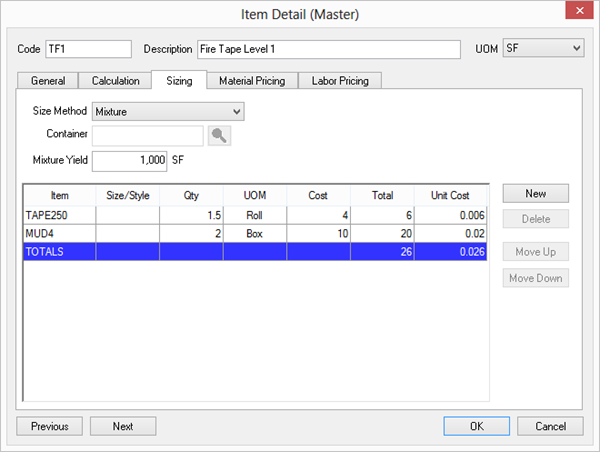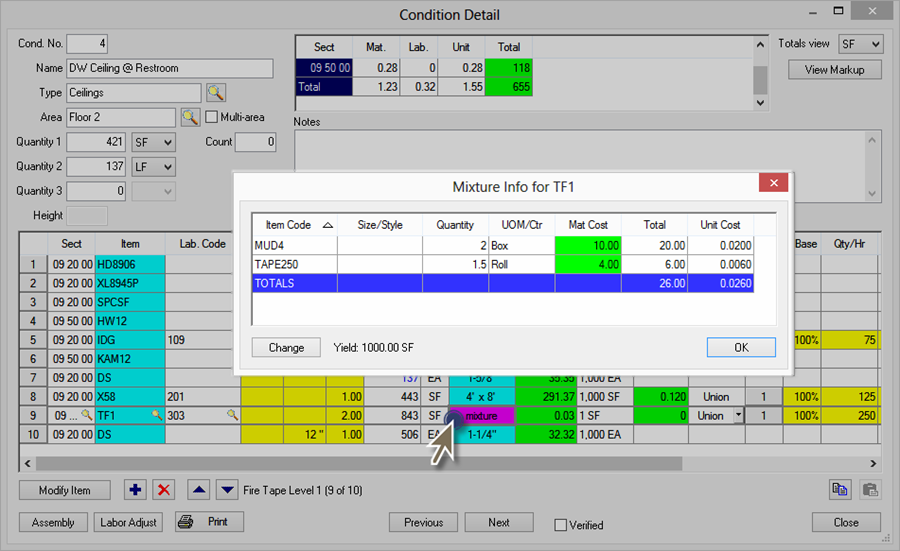What are Mixtures?
Mixtures allow you to enter specific material quantities for a combination of materials required for a given coverage or yield.
Mixtures also allow you to combine a group of Material Items into a single line entry in a Condition Detail where Labor will apply to the mixture.
In our "Sample"
database, Item Code TF1 (Fire Tape 1) is a mixture of two other material Items: Tape-250 and Mud4. These materials are listed below the Yield of 1,000SF.
Another advantage of a Mixture is that it allows you to manipulate the original UOM of a material by entering that material into a mixture containing a different UOM. For instance, an anchor or clip typical has EA as its UOM. However, if you wanted to calculate a specific number of anchors or clips based upon the LF of an object (beam, wall, etc.), you could build a Mixture Item that uses an incoming UOM of LF and outputs the number of “EA” Items required for a given linear yield.
Items that are "sized" as "Mixtures" are displayed in pink in the Item List.
Setting Up Mixtures
Mixture Yield
If you are setting up a Mixture and previously set the Material Pricing tab "Price Per" to something other than "1", you need to return to the Material Pricing tab before setting the Size Method to "Mixture", set the "Price Per" to '1', then return to the Sizing tab and select "Mixture". This only happens if you adjust the Material Pricing "Price Per" before setting the Item to "Mixture" - which rarely happens.
When you setup an Item as a Mixture, you will need to specify the Yield - this tells Quick Bid that so much of "X" and "Y" (the component Items) covers so much of "Z" (the yield).

Example of a common Mixture, TF1 (Tape and Float Level 1)
Mixture Components
When "Mixture" is selected as the Size Method, a grid appears along with a "Mixture Yield" field ("Container" becomes greyed-out because the component Items' Containers are used).
Enter a Mixture Yield (a round number is typical). The yield is a estimated coverage value with its base measure (LF, SF, etc.) controlled by the UOM shown in the upper right corner of the record. In the example above, the Mixture covers 1000 SF.
Next, add Items to the Mixture Grid to define what Materials and how much of each is required to produce the given "Mixture Yield". In the example above, 1.5 rolls of tape and 2 boxes of mud are required to complete 1000 SF.
Click New - a blank line displays.
Click the Lookup button  - this opens the Master Item List.
- this opens the Master Item List.
Select the Items to include in the Mixture.
In the "quantity column" enter the amount of material required for the indicated yield. The format for entering this quantity is controlled by the container name as assigned at the Sizing tab for the Item being entered. For example, the sizing default for a fastener may contain 10,000 pieces/carton, if only 1000 pieces are needed for the yield, the entry in the Mixture's quantity column would be 0.10 indicating a 1/10th of this Container is needed (1000 pieces).
Viewing a Mixture in a Condition
When you add (insert, drop in) a Mixture Item into the Condition Detail Item Grid, the Size box turns into a pink Mixture button, click this button to open the Mixture Info dialog box. In this pop-up, you can the components of the mixture and adjust component Materials' pricing.
The Mixture setup cannot be changed, with the exception of Material Cost, from within a Condition.
To change the Mixture (component Item(s), Labor pricing, or production information), you open the Item Detail for the Mixture - just click "Change" on the pop-up to open the Mixture's Item Detail dialog box.
To change the component Item's details, you will need to modify the Item from the Materials Tab. You cannot edit a Component Item's details from the Mixture pop-up.

